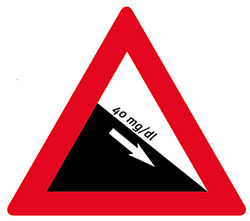Hypoglycaemia – blood glucose too low
Symptoms and treatment
Recognize and avoid hypoglycemia
Hypoglycaemia, also known as low blood sugar, is a drop in blood sugar, a metabolic derailment. By definition, this is referred to as blood sugar levels below 60 mg/dl. Hypoglycaemia can lead to unconsciousness or even be life-threatening. Therefore, you should recognize the first signs of this in order to quickly return blood sugar levels to normal.
Blood sugar levels below 60 mg/dl lead to a lack of sugar in the body (especially in the brain) and thus to a lack of energy. The typical warning symptoms can already appear at a value of 80 mg/dl (or higher) when the blood sugar drops steeply. Within a few minutes a serious hypoglycaemia can occur.
Possible Causes:
forgotten to eat
too little carbohydrates eaten
increased physical activity without additional intake of carbohydrates
inadvertently too much insulin injected or several tablets to lower blood sugar levels
excessive drinking
diarrhoea or vomiting
The symptoms are different, depending on how fast or how low sugar levels fall down.
Typical symptoms:
Shakiness
Increased frequency of the heart
Cold sweat
Low concentration level, dizziness
Balance disorders
Labile mood, aggression,huffiness
It is important to act quickly to supply the person with sugar, first 1-2 quick-acting bread units (ca 24g carbohydrates), then to control blood glucose level and maybe to continue to supply more sugar. It is important that fast acting carbohydrates are supplied (e.g. invert sugar syrup, which quickly brings energy into the body via the oral mucosa), so that the blood sugar rises again quickly. To avoid repeated decrease of the blood glucose level the person should eat at the end one or two longer-acting bread units, e.g. yoghurt or bread. But be careful not to eat uncontrolled or enormous high amounts of carbohydrates to avoid extreme high blood glucose levels afterwards.
If a person with diabetes becomes unconscious due to hypoglycaemia he needs help from another person. An injection of Glukagone is needed – into the skin or a muscle. Helping persons should not be shy – it is better to do it wrongly than to do nothing!

